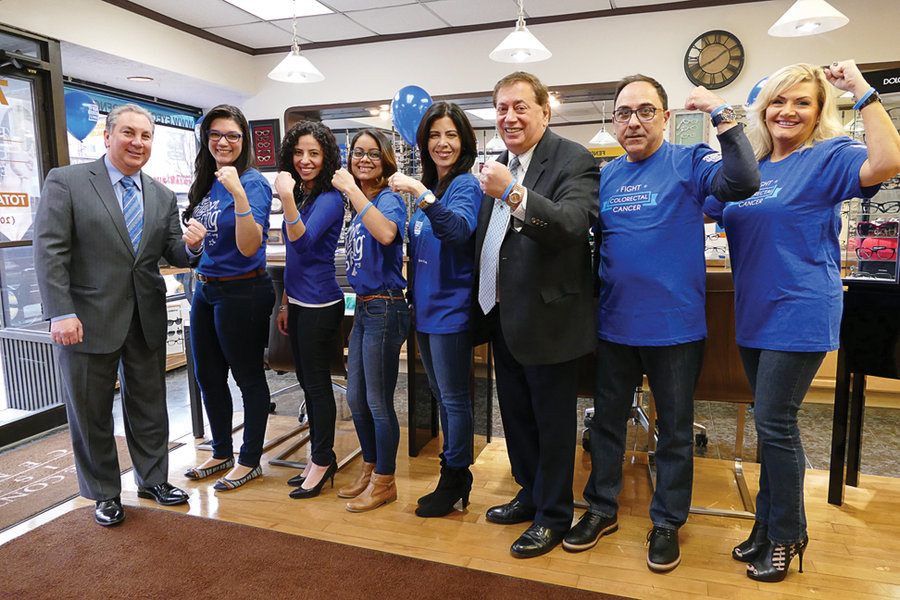Colorectal cancer is a stealthy assassin. The very name makes people uncomfortable, and because people are reluctant to talk about it – much less undergo screenings and tests even when they are most at risk – the disease continues to thrive and grow.
That’s why local business owner Bob Ceragno has made it his mission to spread awareness of the disease during March, Colorectal Cancer Awareness Month.
For Ceragno, it’s personal. He is a survivor of colorectal cancer. But only because it was caught and treated early. Ceragno was diagnosed around Memorial Day and within a period of about nine days he underwent a whirlwind of testing, biopsies, and eventually surgery to remove the cancer.
Colorectal cancer is treatable if detected early.
____________
For every pair of eyeglasses purchased in March, Ceragno is donating $10 to the organization Fight Colorectal Cancer. For every pair of blue glasses, because blue is the official color of the organization and the fight, he will donate $20.
Individuals can also go on the website eyecontactofnorthbergen.com and click on the “creating awareness” button to donate.
Message in blood
Ceragno first realized there was a problem when he saw blood in the toilet. A lot of it.
He immediately made an appointment with his doctor, who confirmed there was a problem and sent him pronto to get a colonoscopy.
The colonoscopy and subsequent biopsy revealed the worst. “They found polyps that had cancer, but they couldn’t get them all out so I had to go for surgery,” said Ceragno. He underwent a colon resection, meaning a removal of a portion of his colon. He has nothing but praise for the doctors and procedures at Englewood Hospital, where he underwent treatment.
“The summer was brutal,” he said. “I had to run back and forth to the hospital because I was constantly dehydrated. I went every day for eight weeks for radiation.”
Rather than intravenous chemotherapy, he took six pills a day until his system couldn’t handle it anymore and the regimen was reduced to two weeks on the pills and one week off.
In addition to “living in the bathroom,” he was in enough pain to require a visit to a pain clinic. They put him on a time-released pain medication and prescribed medical marijuana.
“It’s an amazing drug and should be legalized,” he said of the marijuana. Becoming a legal user required not only a medical prescription, which is highly restricted, but registration through the state, a $200 ID card, and a hard-to-get appointment at a legal dispensary.
“They bring out a catalog with all these pictures” of marijuana varieties, he described. “I have two strains. There’s one that’s supposed to pick you up a little bit during the day, and then another one that relaxes you at night. It helps dramatically. My whole body just relaxed. I don’t use it that much anymore. I really needed to be on it mid-summer when I was really in treatment.”
#2 cause of cancer deaths in the U.S.
The colon, also known as the large intestine, is about five to six feet long. The last five to 10 inches are known as the rectum. “Colorectal cancer occurs when abnormal cells form tumors in normal tissues of the intestines and digestive system,” reads the website for fightcolorectalcancer.org. “CRC may have no symptoms at first, but as the tumor grows, it can disrupt the body’s ability to digest food and remove waste, causing potentially severe bowel and abdominal problems.”
Colorectal cancer is the number two leading cause of cancer deaths among men and women in the U.S. It accounts for nearly 10 percent of cancer deaths in the U.S. It is estimated that this year, 137,000 men and women will be diagnosed with colorectal cancer while another 50,000 will die from it.
While over 90 percent of colon and rectal cancers are found in people over the age of 50, anyone at any age can get colorectal cancer. The good news is that it can be treated and cured if caught early.
That means going for regular screenings if you are at risk due to age, family history of cancer, or if symptoms appear.
Among the groups least likely to go for screenings are Hispanics and people with lower income. Also African-Americans, who are more likely to develop colorectal cancer.
Spreading awareness to save lives
The Township of North Bergen has joined the campaign to spread awareness of the disease. “The town will be advocating colorectal awareness because it’s one of the most preventable cancers,” said Public Health Director Janet Castro. “We will be partnering with North Hudson Community Action, and when they do their free monthly vaccines we will go out with them into the community.”
Representatives will also provide brochures and information at events like North Bergen’s annual Health and Green Fair over the summer. They hope to bring speakers from Englewood Hospital to provide presentations at the library’s regular health seminars.
In addition, the Nicholas J. Sacco Foundation is donating to fightcolorectalcancer.org to support research and treatment of the disease. Residents can help by donating online, contributing to a collection box in the store, or buying glasses.
Ceragno will receive citations from the township and the county at a future commission meeting for his vigorous efforts to bring awareness to the public.
Art Schwartz may be reached at arts@hudsonreporter.com.
